| |
Advanced
Editing |

You can move the camera's around easier in the 2D
views by holding [CTRL] while moving them.
|
Using
the Camera effectively
Now that your level is starting to get a bit bigger, you'll want
to know how to save time using the camera. You should already know how
to move about your level with the camera fairly well now, but you can
add more cameras at different points, and save yourself time when travelling
all over your map.
To place a new camera, you hold [Shift] and then left-click-hold-drag
a camera like normal. To cycle through the cameras, press [PageUp] and
[PageDown]. Press [Delete] to delete the current camera. The active camera
in the 2D view will be drawn with a red line, and it moves along with
you when you move in the 3D window. This will make navigating your level
much easier. Another great feature of Worldcraft's cameras, is that they
are saved in the .RMF file. You won't need to position
the cameras every time you open the map.
|

Group, and UnGroup Buttons
You can select multiple objects in any view by selecting
the first object, and then holding [CTRL] and then clicking more objects.
|
Groups
Before we get to VisGroups, lets make sure you fully understand
the "Group" function. You know that when you act on an object by carving,
or hollowing, even though it is split into many pieces, they are still
grouped usually together as one group. This makes it easy to select those
objects together or move those objects as a group. At any time, you can
group any number of selected objects, and you can also group two groups
into one group. When you Group two groups into one they will retain their
individual groups in layers, ungrouping them later
will give you the original two groups.
|

VisGroups Buttons 
Hide selected objects

Hide UNselected objects

Show all VisGroups
|
VisGroups
is probably Worldcraft's greatest "unused" feature. Many of the old
Worldcraft level designers don't use this handy feature partly because
it used to be harder to use, and it had a few bugs. There's nothing wrong
with it now, and is an important feature. Not to be confused with "VIS",
the program used to finish the compiling of your level.
There are essentially two reasons to use VisGroups, "speed" and "visibility".
If you have a slow computer, things will get slower and slower as you
build a fairly large map, using VisGroups effectively can speed things
up because you can hide portions of your map, cutting the number of items
Worldcraft has to deal with at once. As for visibility, when you level
gets big there may be room upon room overlapping in the different views,
making it hard to grab or manipulate the specific items you are trying
to work with. Hiding some of the clutter makes it a lot easier to work
faster.
Hiding Objects, or not hiding objects, that's what VisGroups is about.
You can select any portion of your map, and then either hide it (Hide
selected objects) or hide everything except it (Hide UNselected
objects). Fairly straight forward so far. From there you manage what's
visible and what's not by using the VisGroups window. Any group
with an " "
will be visible, ones without will not. If you want to see everything
in your map, click Show all VisGroups. "
will be visible, ones without will not. If you want to see everything
in your map, click Show all VisGroups. |
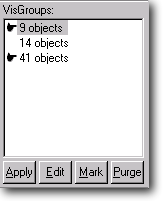 |
Managing
VisGroups is done in the VisGroups window. Clicking
the space at the front of each group of objects will toggle the pointer
" "
which will indicate if that group will be visible or not. After you select
the groups that you want to be visible, you must click [Apply]. You can
change the name and color of any VisGroup by highlighting the group, and
clicking [Edit] it should be pretty straight forward. "
which will indicate if that group will be visible or not. After you select
the groups that you want to be visible, you must click [Apply]. You can
change the name and color of any VisGroup by highlighting the group, and
clicking [Edit] it should be pretty straight forward.
In the [Tools => Options] 2D Tab you'll find a check box to toggle
"use VisGroups colors for object lines". When enabled The VisGroups own
color is applied to the objects in the 2D and 3D.
Any object in your map can only belong to one VisGroup at a time, so if
you select it and add it to a new VisGroup, it will automatically be removed
from it's previous VisGroup.
To delete a VisGroup, simply drag it out of the VisGroups window, you
will be prompted to verify the delete. The [Purge] button removes VisGroups
from the list which no longer have any objects left in them.
For a quick look at just one room in your map, hide everything in your
map except the room, using VisGroups, then when you compile, click the
"Save Visible objects only" box on the compile options window.
This will compile your map with only the objects that are visible in the
2D and 3D windows. Doing so can save a lot of compile time if you just
want to check out the layout, scale, or lighting of just one room. |
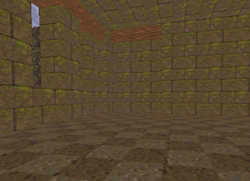
Example of Fullbright, or "flat" Lighting
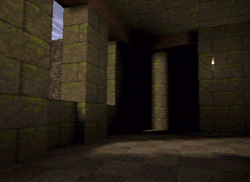
Level Shown with atmospheric lighting
|
Lighting
Lighting can make or break your map. Paying attention to lighting
detail can turn a good map into a great map. Dramatic lighting can add
miles of realism to your levels, and set an overall mood for the players
to enjoy, and feel. Maps that are overly bright, or have the exact same
amount of light everywhere (flat lighting) are generally unattractive,
and uninteresting. Trying to make the light seem like it comes from actual
light sources (atmospheric lighting) instead of just "being there"can
take quite a while, but is always worth it.
The options for the types of lights are up to you. There
can be just a few really bright lights, or lots of dimmer lights, or
any combination. Whatever looks best to you in each situation. Wall
torches look nice in levels where they match the theme, however are
not recommended for large rooms in multiplayer levels as they can add
to the lag. The same can be said for any of the pulsing or or flashing
lights. These lights are all classified as "dynamic", and are rendered
real-time during play which is where the lag comes in. You create these
types of lights by using the "appearance" key in the properties of the
light.
Spotlights,
if used right with normal lights can enhance some situations.
To make a spotlight, place an ordinary light entity approximately where
you think the light source would be, then open the properties box to
edit it's properties. Give it a "target" ,such as "spot1", adjust the
brightness, spotlights often require a higher value, such as 600. Now
create an entity "info_null" roughly where you want the spotlight to
shine. Edit the properties of the "info_null" and give it a "name" the
same as the light, in this case "spot1". That's it, providing that the
light isn't too far from the target, you should see the spotlight in
your level the next time you compile. Play around
with these until you feel comfortable with them.
|
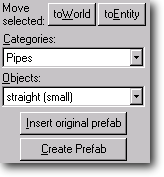
!
When you want to go back to making blocks, cylinders, wedges and spikes,
they are in the "primitives" category.
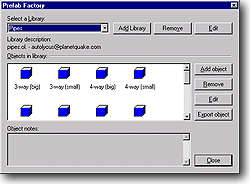
|
Prefabs
If you are a registered user of Worldcraft, you can use the prefabs
function. This is a great time saving feature when you want to use an
object repeatedly, or save it for use in other maps. Lots of different
items can be saved as prefabs, such as lighting fixtures, pipes, complex
hallways, tables, desks, almost anything you would want to use again in
future maps. The registered CD comes with several prefab libraries for
you to use right away, and many more can be found on the Forge site, and
on other sites around the internet. The file extension for prefabs is
.ol , which stands for object library. They will all
reside in the 'prefabs" subdirectory of where your Worldcraft is installed.
Adding an existing prefab to your level is easy, simply
change the Categories: from Primitives to any of the
prefab libraries that you have installed, such as Pipes. Once
you have selected a library, go to the next window down, Objects:,
it will contain all the different prefab objects within the above chosen
library. Select a prefab that you want, and click [Insert original prefab],
that will put an exact copy of that prefab into your level.
Making your
own Prefab Libraries is easy too. First thing you'll have to do is create
a library where you'll put your own prefab objects. Do this by opening
the "Prefab Factory", select [Tools => Prefab factory] , the prefab
factory will open. To
make a new Library of your own, click [Add Library], a window will pop
up, you only need to name your library. If you want, you can write in
a description or your e-mail address, but that's only really necessary
if you are planning to distribute your prefab library. Once you've created
your own prefab library you can save something in it. Close the Prefab
Factory for now, and select the objects that you want to make into a
prefab. For ease of handling later, "group" those objects, now simply
click the [Create Prefab] button, a box will come up allowing you to
pick a name for this new prefab, a description (not necessary), and
the prefab library that you want to put this prefab into. Fill in the
information and select your library, then click [OK]. You're done, you
have you're own usable prefab now. To
make a new Library of your own, click [Add Library], a window will pop
up, you only need to name your library. If you want, you can write in
a description or your e-mail address, but that's only really necessary
if you are planning to distribute your prefab library. Once you've created
your own prefab library you can save something in it. Close the Prefab
Factory for now, and select the objects that you want to make into a
prefab. For ease of handling later, "group" those objects, now simply
click the [Create Prefab] button, a box will come up allowing you to
pick a name for this new prefab, a description (not necessary), and
the prefab library that you want to put this prefab into. Fill in the
information and select your library, then click [OK]. You're done, you
have you're own usable prefab now. |
Details
Great levels don't happen by mistake. Paying close attention
to all the details in your map will make a difference. Lighting, architecture,
texture choices, texture alignment, scale of objects and areas, object
and entity placement and more.
Hallways don't have to be just 4 plain surfaces, try adding some details
or angle the walls slightly, ribs, light fixtures, or access panels, anything
to add detail. Try to come up with something nobody has thought of, good
architecture includes good detail.
Spend some time studying other levels, id's Rituals, etc. They put in
the time and details that make levels great, and now it's your turn. |
| |
|